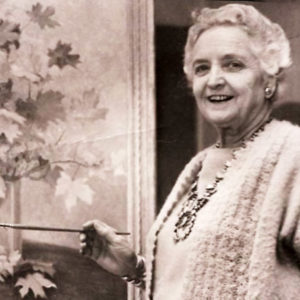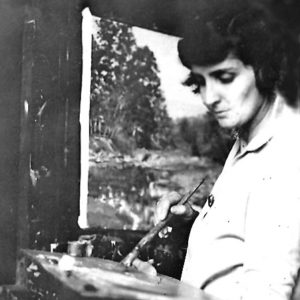calsfoundation@cals.org
Kathryne Bess Hail Travis (1894–1972)
Kathryne Bess Hail Travis was an artist and teacher who was especially known for her still-life paintings of flowers. For a three-year period in the late 1920s, she and her then-husband, artist Olin Travis, ran the Travis Ozark Summer Art School near Cass (Franklin County).
Kathryne Bess Hail was born in Ozark (Franklin County) on February 6, 1894. She was the only child of Albert Eugene Hail, who owned a general store, and Maude (Brown) Hail. Her education was financed and closely supervised by a wealthy uncle, Oliver Brown. She studied art in high school and graduated with honors from Galloway College in Searcy (White County) in 1911. She briefly attended a girls’ school in Chicago, Illinois, before enrolling in the School of the Art Institute of Chicago (AIC) in 1911. After leaving the AIC in 1912, she continued her art studies in 1913 at the Academy of Fine Arts in Cincinnati and later at the Ohio Mechanics Institute. Her instructors included renowned painters George Bellows, Robert Henri, and Randall Davey.
Around 1915, Hail briefly opened a studio in Fort Smith (Sebastian County). In 1916, she returned to AIC for additional instruction. In November of that year, she married Olin Herman Travis, a former instructor at AIC, in Ozark; they had two children. The Travises worked in the Chicago area before relocating to Dallas in 1923, where they established the Dallas Art Institute (DAI) with James Waddell. The first major art school in the South to offer instruction in a variety of fields, DAI existed until 1945. Kathryne Travis also served as an instructor in art at the Hockaday School for Girls in Dallas in 1924. She resigned from DAI in 1931.
In the summer of 1927, the Travises established the Travis Ozark Summer Art School at an abandoned sawmill near Cass, not far from where Kathryne was born. The school, which was an adjunct of DAI, was held each summer for three years. Attended by up to fifty students, the school held classes for a period of one to two months beginning in June. There were about fifteen crudely furnished cabins and a lodge at the camp. Classes were open to not only DAI students but also to Arkansas residents and others from surrounding states. On weekends, the students exhibited their paintings, held dances, and put on impromptu performances.
Although trained as a portraitist, Travis became well known for her landscape and still-life paintings. In February 1930, a painting of wisteria by Travis graced the cover of Holland’s magazine. In 1936, another of her still-life paintings, Texas Centennial Rose, appeared on the cover of the June issue of Holland’s. Fresh roses that had been specially cultivated in Tyler, Texas, had served as models. This painting was also featured at the Texas Centennial Art Exhibit that fall.
In 1934, the Travises divorced, an event much publicized in Dallas and Denver newspapers. Travis completed a self-portrait painting, The Unfinished Picture, in 1936, causing a stir for its overt symbolism related to the breakup of her marriage. This painting was displayed at the Dallas Museum of Fine Arts in January of that year and is currently on loan to the El Paso Museum of Art.
Travis moved to Beverly Hills, California, in 1936 and began to focus more on landscape and portrait painting. She remained there for the next ten years, returning to her hometown of Ozark for a short period in 1944. She resettled in Seattle, Washington, in 1946. From the mid-1930s until the early 1950s, Travis worked in many western states, including California, Oregon, Washington, Colorado, and Alaska. During this period, she returned to paint periodically in Arkansas, Texas, and New Orleans, Louisiana. Like many Americans, she was pressed into defense work on an assembly line for Lockheed Aircraft Co. while in California during World War II.
Travis moved back to Dallas in 1952, opened an art gallery, and took a position as the head of the art department at the Arts Center Studio School. She also offered art instruction at her own studio in Dallas and, in 1957, opened the Kathryne Hail Travis Summer School of Painting in Ruidoso, New Mexico. In 1960, she moved permanently to Ruidoso.
Although comfortable working in both pastels and watercolors, her preferred medium was oils. When working on location, she typically made quick sketches in pastel or took photographs and then worked her best ideas into fully realized paintings in oil. Known for her expertise in flowers and plants, Travis had performed extensive research on the symbolism and lore associated with various flora. Many of her still-life paintings featured wildflowers from the locales where she worked.
Travis was also known for her collection of quilts that she acquired during her many trips to Arkansas to visit family and paint. She was interested in not only the patterns but also the history and symbolism associated with quilts. In 1930, she wrote an article in Southwest Review about her experiences collecting quilts in the Ozarks.
Travis died in Ruidoso on January 10, 1972. She was cremated, and her ashes were scattered in Ozark.
For additional information:
Obituary of Kathryne Hail Travis. The Spectator. January 20, 1972, sec. 1, p. 3.
Powers, John, and Deborah Powers. Texas Artists, Sculptures, and Graphic Artists. Austin, TX: Woodmont Books, 2000.
Travis, Kathryne Hail. “Quilts of the Ozarks.” Southwest Review 15 (Winter 1930): 236–244.
W. Russ Aikman
University of Texas at Arlington
 Arts, Culture, and Entertainment
Arts, Culture, and Entertainment Early Twentieth Century, 1901 through 1940
Early Twentieth Century, 1901 through 1940 Kathryne Travis
Kathryne Travis  Kathryne Travis
Kathryne Travis 




I was very gratified to see that my grandparents, Kathryne Hail Travis and Olin Herman Travis, are mentioned at length. I grew up in Ozark. My mother is Jean Moncrief Travis Patterson, daughter of Olin and Kathryne. We moved to Dallas when I was a youngster, and I spent many a day listening and talking with my Grandaddy, him telling wonderful tales of his early days spent in the Ozark area. I even, during graduate studies at the University of Texas at Austin, interviewed both him and Josephine [Olin Traviss second wife] for my folklore class. I spent many days and weeks in the company of my beloved grandmother, I knew her as Bobby Bessshe was a most marvelous person.